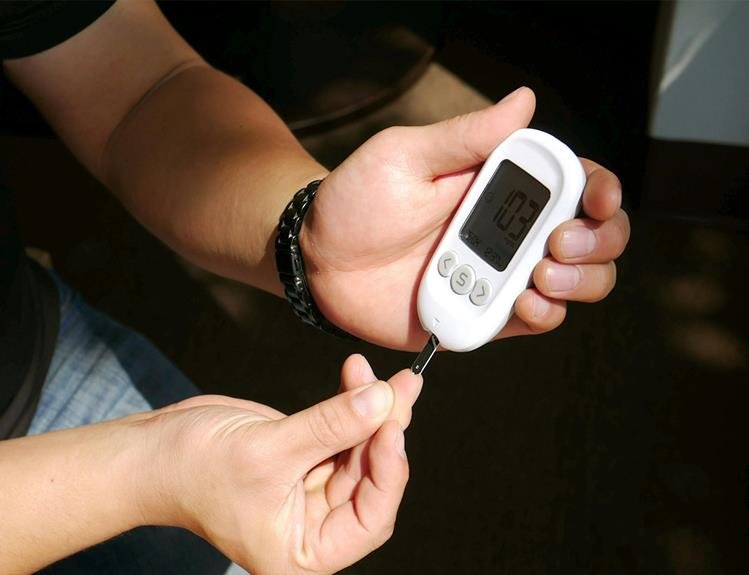Understanding Prediabetes: Symptoms Causes
Imagine your body as a silent messenger, dropping subtle hints like whispers in the wind. When it comes to prediabetes, these whispers are vital clues that shouldn't be ignored.
Understanding the symptoms and causes of prediabetes is like deciphering a cryptic code that holds the key to your future well-being.
As you explore the intricate connection between prediabetes symptoms and underlying causes, you'll uncover a fascinating journey that could transform the way you view your health.
Common Symptoms of Prediabetes
If you experience frequent thirst and unexplained fatigue, these could be common symptoms of prediabetes. It's essential to pay attention to these signs as they may indicate an underlying issue with your blood sugar levels. Alongside thirst and fatigue, you might also notice increased hunger, especially after eating. This constant feeling of hunger even after meals can be a red flag for prediabetes.
Furthermore, blurred vision is another symptom that individuals with prediabetes might experience. If you find your vision becoming blurry or slightly impaired, it's advisable to consult a healthcare professional for further evaluation. Additionally, some people with prediabetes report tingling sensations or numbness in their hands or feet. These sensations, known as neuropathy, can be a result of nerve damage caused by fluctuating blood sugar levels.
Risk Factors for Prediabetes
When it comes to prediabetes, certain risk factors play a significant role in determining your likelihood of developing this condition.
Understanding these common risk factors and how lifestyle choices can influence your prediabetes risk is crucial for taking proactive steps to manage your health.
Common Risk Factors
Understanding the common risk factors for prediabetes is essential for taking proactive steps towards prevention and management. Some common risk factors include being overweight, especially if you carry excess weight around your abdomen. Genetics also play a significant role; if you have a family history of type 2 diabetes or prediabetes, your risk increases.
Age is another factor, with individuals over 45 being more susceptible. Additionally, leading a sedentary lifestyle and not getting enough physical activity can contribute to prediabetes. High blood pressure and abnormal cholesterol levels are warning signs too. Being aware of these risk factors can help you make informed decisions to lower your chances of developing prediabetes.
Lifestyle Influences
To reduce your risk of prediabetes, adopting healthier lifestyle habits is crucial. Maintaining a healthy weight through a balanced diet and regular physical activity can significantly lower your chances of developing prediabetes.
Eating a diet rich in fruits, vegetables, whole grains, and lean proteins while limiting processed foods, sugary beverages, and high-fat foods can help regulate blood sugar levels. Engaging in at least 150 minutes of moderate exercise per week, such as brisk walking or cycling, can improve insulin sensitivity and reduce the risk of prediabetes.
Additionally, managing stress levels, getting an adequate amount of sleep, and avoiding smoking and excessive alcohol consumption are all lifestyle factors that can play a role in preventing prediabetes.
Diagnostic Tests for Prediabetes
Diagnostic tests play a crucial role in identifying prediabetes early on, allowing for timely intervention and management. If you suspect you may have prediabetes based on risk factors or symptoms, your healthcare provider may recommend specific tests to confirm the diagnosis.
The most common test for prediabetes is the fasting plasma glucose test, which measures your blood sugar levels after fasting for at least eight hours. Another commonly used test is the oral glucose tolerance test, where your blood sugar levels are measured before and two hours after consuming a sugary drink. Additionally, the hemoglobin A1c test provides an average of your blood sugar levels over the past two to three months.
These tests help healthcare professionals assess your risk of developing type 2 diabetes and determine the appropriate steps for prevention. Early detection through these diagnostic tests can empower you to make lifestyle changes and reduce the progression to full-blown diabetes.
Lifestyle Factors and Prediabetes
Identifying lifestyle factors that contribute to prediabetes is essential for effectively managing your risk and preventing the progression to type 2 diabetes. One major lifestyle factor linked to prediabetes is poor dietary habits. Consuming high amounts of sugary drinks, processed foods, and unhealthy fats can increase your risk.
Lack of physical activity is another significant contributor. Leading a sedentary lifestyle can lead to weight gain and insulin resistance, both key factors in prediabetes development. Additionally, smoking and excessive alcohol consumption have been associated with an elevated risk of prediabetes. Stress and poor sleep patterns can also play a role in the development of this condition.
To reduce your risk of prediabetes, consider making small but impactful changes to your lifestyle. Incorporate more whole foods, fruits, vegetables, and lean proteins into your diet. Aim for at least 150 minutes of moderate exercise per week and try to quit smoking if you currently do. Limit alcohol intake and find healthy ways to manage stress and improve your sleep quality. By addressing these lifestyle factors, you can take proactive steps towards preventing prediabetes and maintaining your overall health.
Genetic Predisposition to Prediabetes
Having a genetic predisposition can significantly influence your likelihood of developing prediabetes. If you have family members with prediabetes or type 2 diabetes, your risk of developing prediabetes may be higher due to shared genetic factors. Genes play a crucial role in how your body processes glucose and insulin. Some genetic variations can affect insulin production, insulin resistance, or how your body stores fat, all of which are linked to prediabetes.
Understanding your genetic predisposition can help you take proactive steps to lower your risk. While you can't change your genetics, you can modify your lifestyle to reduce the impact of genetic factors. Eating a balanced diet, exercising regularly, and maintaining a healthy weight can help lower your risk of developing prediabetes, even if you have a genetic predisposition. By being aware of your genetic risk, you can work with your healthcare provider to create a personalized plan to prevent or manage prediabetes effectively.
Complications of Untreated Prediabetes
If left untreated, prediabetes can significantly raise your health risks, increasing the likelihood of developing diabetes and potential heart disease complications.
Ignoring prediabetes can lead to a higher chance of facing serious health issues down the line, making early intervention crucial in preventing more severe conditions.
Take action now to manage your prediabetes and reduce the risks associated with its progression.
Health Risks Increase
Untreated prediabetes significantly increases your risk of developing serious health complications. If left unmanaged, prediabetes can progress to type 2 diabetes, leading to a higher likelihood of heart disease, stroke, kidney damage, nerve problems, and vision loss.
High blood sugar levels associated with prediabetes can also damage blood vessels over time, raising the risk of cardiovascular issues such as heart attacks and peripheral artery disease. Furthermore, untreated prediabetes can impact your quality of life, potentially resulting in chronic fatigue, increased susceptibility to infections, and slower wound healing.
Diabetes Development Likelihood
Ignoring prediabetes significantly heightens your risk of developing diabetes and its associated complications. If left untreated, prediabetes can progress to type 2 diabetes, where your body struggles to regulate blood sugar levels effectively. Diabetes can lead to various severe complications such as heart disease, kidney damage, nerve problems, and vision loss.
Once diabetes develops, managing the condition becomes a lifelong commitment that requires monitoring blood sugar levels, adhering to a strict diet, and possibly taking medications. Additionally, diabetes increases the risk of developing other health issues over time.
Heart Disease Potential
Addressing prediabetes early through lifestyle changes like adopting a healthy diet and engaging in regular exercise can significantly reduce the risk of heart disease associated with untreated prediabetes.
Untreated prediabetes can lead to complications such as a higher likelihood of developing cardiovascular issues. High blood sugar levels, common in prediabetes, can damage the blood vessels and the heart over time, increasing the risk of heart disease.
Additionally, untreated prediabetes often goes hand in hand with other risk factors for heart disease like high blood pressure and abnormal cholesterol levels. By managing prediabetes through healthy habits and regular monitoring, you can decrease the chances of developing heart problems and improve your overall health in the long run.
Frequently Asked Questions
Can Prediabetes Be Reversed Through Lifestyle Changes Alone?
Yes, prediabetes can often be reversed through lifestyle changes alone. By making adjustments to your diet, increasing physical activity, and managing stress levels, you can improve your health and potentially lower your risk of developing diabetes.
Are There Any Specific Foods or Supplements That Can Help Prevent the Progression of Prediabetes?
Wondering if certain foods or supplements can halt prediabetes progression? Incorporate a balanced diet rich in whole grains, fruits, vegetables, lean proteins, and healthy fats. Stay active and maintain a healthy weight for optimal prediabetes prevention.
How Often Should Someone With Prediabetes Be Monitored by a Healthcare Provider?
You should see your healthcare provider regularly for monitoring if you have prediabetes. Typically, it's recommended to have check-ups every 3 to 6 months to track your progress, discuss any concerns, and make necessary adjustments.
Is There a Link Between Prediabetes and Other Health Conditions, Such as Heart Disease or Stroke?
Yes, there is a strong link between prediabetes and other health conditions like heart disease and stroke. Monitoring your blood sugar levels regularly, maintaining a healthy lifestyle, and consulting with healthcare providers can help manage these risks effectively.
What Role Does Stress Play in the Development and Management of Prediabetes?
Stress impacts prediabetes by raising blood sugar levels and affecting insulin response. Managing stress through techniques like exercise and mindfulness can help control your blood sugar levels and reduce your risk of developing prediabetes.
Conclusion
So, now you know the signs and risks of prediabetes. Remember, it's like a warning light on your dashboard – pay attention before it turns into something more serious.
Keep an eye on your lifestyle choices, get tested regularly, and take control of your health.
Don't wait until the engine breaks down, take action now to prevent diabetes from taking over.
It's in your hands to steer clear of this health issue.






